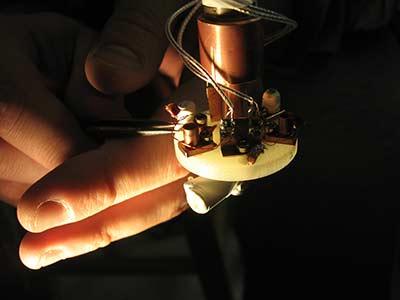Pushing the (extra cold) frontiers of superconducting science

Ames Laboratory has developed a method to measure magnetic properties of superconducting and magnetic materials that exhibit unusual quantum behavior at very low temperatures in high magnetic fields, by placing a tunnel diode resonator, an instrument that makes precise radio-frequency measurements of magnetic properties, in a dilution refrigerator, a cryogenic device that is able to cool samples down to milli-Kelvin temperature range. Credit: Ames Laboratory, US Department of Energy
How cold? Lower than 0.05 Kelvin (-272°C).
“For many modern (quantum) materials, to properly study the fine details of their quantum mechanical behavior you need to be cool. Cooler than was formerly thought possible,” said Ruslan Prozorov, a physicist at the U.S. Department of Energy's Ames Laboratory, who specializes in developing instrumentation which measures just such things.
Prozorov and his research team have developed a method to measure magnetic properties of superconducting and magnetic materials that exhibit unusual quantum behavior at very low temperatures in high magnetic fields. The method is being used to study quantum critical behavior, mechanisms of superconductivity, magnetic frustration and phase transitions in materials, many of which were first fabricated at Ames Laboratory.
They did so by placing a tunnel diode resonator, an instrument that makes precise radio-frequency measurements of magnetic properties, in a dilution refrigerator, a cryogenic device that is able to cool samples down to milli-Kelvin temperature range. While this was already achieved before, previous works did not have the ability to apply large static magnetic fields, which is crucial for studying quantum materials.
Prozorov's group worked to overcome the technical difficulties of maintaining high-resolution magnetic measurements, while at the same time achieving ultra-cold temperatures down to 0.05 K and in magnetic fields up to 14 tesla. A similar circuit has already been used in a very high magnetic field (60 T) when the team performed the experiments at Los Alamos National Lab.
“When we first installed the dilution refrigerator, the joke was that my lab had the coldest temperatures in Iowa,” said Prozorov, who conducts his research where Midwestern winters are no laughing matter. “But we were not doing this just for fun, to see how cold we could go. Many unusual quantum properties of materials can only be uncovered at these extremely low temperatures.”
The group studied pairing symmetry in several unconventional superconductors, mapped a very complex phase diagram in a system with field-induced quantum critical behavior, and recently uncovered very unusual properties of a spin-ice system, “none of which would be possible without this setup,” said Prozorov.
###
The research is further discussed in the paper, “Tunnel diode resonator for precision magnetic susceptibility measurements in a mK temperature range and large DC magnetic fields,” authored by H. Kim, M.A. Tanatar and R. Prozorov; and published as an Editor's Pick in the Review of Scientific Instruments.
Ames Laboratory is a U.S. Department of Energy Office of Science national laboratory operated by Iowa State University. Ames Laboratory creates innovative materials, technologies and energy solutions. We use our expertise, unique capabilities and interdisciplinary collaborations to solve global problems.
DOE's Office of Science is the single largest supporter of basic research in the physical sciences in the United States, and is working to address some of the most pressing challenges of our time. For more information, please visit science.energy.gov.
Media Contact
All latest news from the category: Physics and Astronomy
This area deals with the fundamental laws and building blocks of nature and how they interact, the properties and the behavior of matter, and research into space and time and their structures.
innovations-report provides in-depth reports and articles on subjects such as astrophysics, laser technologies, nuclear, quantum, particle and solid-state physics, nanotechnologies, planetary research and findings (Mars, Venus) and developments related to the Hubble Telescope.
Newest articles

Superradiant atoms could push the boundaries of how precisely time can be measured
Superradiant atoms can help us measure time more precisely than ever. In a new study, researchers from the University of Copenhagen present a new method for measuring the time interval,…

Ion thermoelectric conversion devices for near room temperature
The electrode sheet of the thermoelectric device consists of ionic hydrogel, which is sandwiched between the electrodes to form, and the Prussian blue on the electrode undergoes a redox reaction…

Zap Energy achieves 37-million-degree temperatures in a compact device
New publication reports record electron temperatures for a small-scale, sheared-flow-stabilized Z-pinch fusion device. In the nine decades since humans first produced fusion reactions, only a few fusion technologies have demonstrated…





















